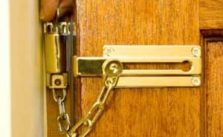
More Door Security Information
Locks For Patio Doors
Sliding patio doors are supplied with integral locks, and several different locking systems are used, ranging from a simple hook and bar to elaborate multi-point locking bolts. Old doors generally have a very low level of security, with the locks easy to force and the doors capable of being lifted off the tracks from inside. More modern doors are generally better, but unless they incorporate key-operated multi-point locking and anti-lift devices, you should add surface mounted key operated patio door bolts to the door frame at the top and bottom. These are now a requirement of many household insurance companies.
Take care when sitting the bolt bodies so that the holes you have to drill in the doors will clear the edges of the double glazed panes. Do not attempt to fit these bolts to the UPVC patio doors, which should incorporate adequate built-in security features. Contact the door manufacturer for advice if you want to upgrade them further.
An alternative way of locking patio doors is with a locking bar. This fits between the frame against which the sliding door closes and the end of the fixed pain, locking the two together to prevent both forcing and lifting. It locks automatically on closing and is key operated.
Bolts For Doors
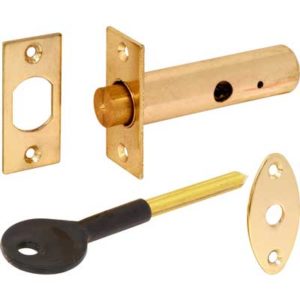
You can provide additional security for your doors by fitting bolts of various types. The simplest is the surface mounted barrel bolt, which you can use to secure hinged back doors (including outward opening French doors). However, these are only as secure as their screw fixings and can be opened from outside if the can be reached through a broking pane in or beside the door, or through a letterbox or cat flap. Lockable key-operated types are better than ordinary bolts in this respect.
Mortise rack bolts are better for backdoors. They have a cylindrical casing which fits in a hole drilled in the side or top edge of the door and shoots a bolt into a hole drilled in the door frame at the turn of a key. For maximum security fit two to each door, one at the top and one at the bottom. The lock is operated from within the house only by a standard splined key, so a burglar can, in theory, operate it if he carried a matching key and was prepared to break a window or door frame to reach the lock. Keep your own rack bolt keys away from the door, stored somewhere handy in case you need to use the door as a fire escape.
Hinge bolts or dog bolts are affixed steel pegs that are set into the hinge edge of the door and engage in holes drilled in the door frame when the door is closed. They prevent the hinged side of the door from being forced and are a must for outward opening French doors where the hinge pins are exposed and can be removed from inside. They are fitted in pairs, one just below the top hinge and the other just above the bottom hinge.
Extra Security For Doors
A high-security lock or other device is of little use if the door itself is weak or the frame is in poor condition. An external door should be at least 45 mm thick, and ideally of solid wood with no glass or thin plywood panels. If any of your doors are thinner than this, avoid using mortise locks unless you’re prepared to reinforce the door, and secure the surface mounted locks and bolts with the longest possible screws. For extra security;
replace large panes of ordinary glass in doors and adjacent side panels with wired or laminated glass or all carbonates sheeting.
consider having metal security grills fitted to glass doors in vulnerable positions.
reinforce large plywood door panels, which can be kicked in for entry or escape, by screwing a panel of 12 mm thick plywood to the inner face of the door
repair or replace rotting door frames.
Door Reinforcing Kits
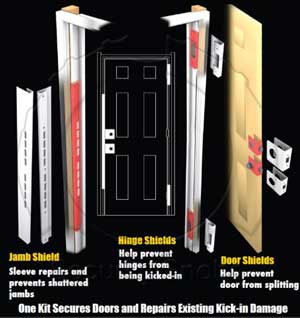
You can buy metal plates which you fit the inner and outer faces of the door that has been weakened by the installation of a mortise lock. The plates are fitted using security bolts so they cannot be removed from the outside. You can also fit frame reinforcing strips to the door frame to strengthen the locking points. Both plates and strips are available from Capital Lock Services.
If the door frame moves when the door is slammed, its fixings need reinforcing. Secure each side of the frame to the walls by drilling through the width with a twist drill, then on into the brickwork with a masonry drill. Insert a special long-sleeved plastic frame plug into the wall until its collar is flush with the frame and tighten the integral screw.
Door Viewers
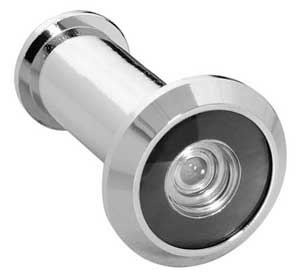
A door viewer is a two-part spy hole which fits in a hole drilled in a solid door. One half of the viewer consists of a wide angle lens housed in a slim tube which is inserted into the hole from outside. The other half is inserted from the inside and then screwed into the lens section to lock the two parts together. You can tighten a knurled (ridged) type by hand, and a slotted type with a large screwdriver or the edge of a small coin. The inner part of the viewer may be fitted with a pivoting cover, which when closed will prevent any indoor light being visible from outside through the viewer.
When installing a door viewer, fit it at the height where it can be used easily by all members of the family, and teach your children the importance of identifying callers before opening the door. Remember that you will not be able to use a door viewer at night unless your porch is well lit.
Door Chains And Limiters
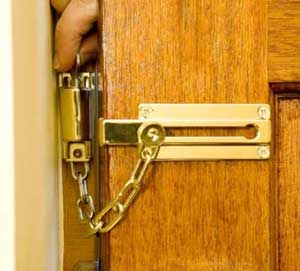
A door chain or door limiter is a device that allows you to open the door a short way in order to vet all callers while preventing someone from pushing his or her way past you and is essential if you have glazed doors where a door viewer would be pointless.
Two types of door limiter are available. The first holds the door ajar with a short length of strong chain, the second with a short rigid bar. In both cases, the keeper is screwed to the inner face of the door, and the fitting with the chain or bar is secured to the door frame. The door has to be closed to allow the chain or bar to be released from the keeper, providing an extra degree of security since the caller cannot release it from the outside. Whichever type is selected, its strength depends on the strength of the fixings, so it is vital to use the longest possible screws to attach the components to the door and its frame. Those supplied with many door limiters are simply not long enough to withstand an attempted forced entry.